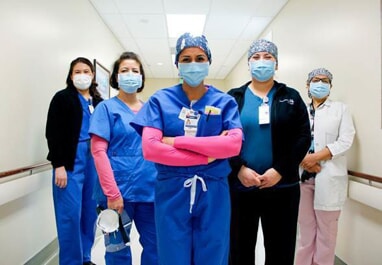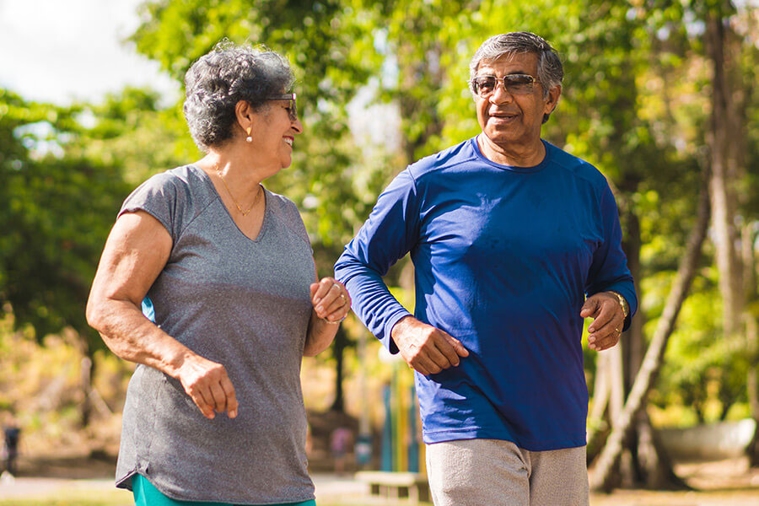
‘We’re their angels’: In pandemic, respiratory therapists are one of the last lines of defense against COVID-19
About this series:It takes all kinds of people to care for a community – especially during a pandemic. Spotlightis our occasional series highlighting the Adventist Health Simi Valley associates who have been keeping our community safe from COVID-19. Some are doctors or nurses, but many are the healthcare heroes working behind-the-scenes to keep our hospital running who aren’t read about as often. This week, we are spotlighting our respiratory therapists.

When Norma walks the halls of the COVID-19 Intensive Care Unit, she watches the glowing numbers on the monitors in patient rooms.
85. 88. 86.
Respiratory therapists like Norma pay close attention to these numbers, which indicate oxygen saturation in the blood. A healthy O2 saturation hovers between 95 and 100 percent, but patients suffering from COVID-19 who are on assisted breathing machines tend to have O2 saturations in the mid-80s.
86. 85. 90.
Norma’s eyes grew a little wider as she slowed down.
“Oh, that’s good – a high number,” Norma said, but she stays grounded. Like all respiratory therapists, she knows that once a patient with COVID-19 is intubated and put on a ventilator, the chances of recovery narrow.
“We just pray and wish for the best,” she said. “It’s so sad.”
If you didn’t know any better, you might mistake a respiratory therapist for a nurse, but their skill sets differ. Respiratory therapists (RT) are specialists who stand watch over patient airways to ensure they can breathe – a job made only more demanding as COVID-19 has infected millions, most notably affecting their lungs.
Respiratory therapists’ jobs were challenging before the pandemic began. They respond to Code Blues (medical emergencies), Code Silents (cardiac arrests), and rapid response triages. They are responsible for maintaining airways when patients are placed on BiPAP machines or high-flow oxygen to assist breathing and oversee them when they’re placed on ventilators. In some hospitals, RTs intubate patients to place breathing tubes.
But nothing has compared to the challenges RTs are facing now with COVID-19, said Bob H., a respiratory therapist at Adventist Health Simi Valley.
“I’ve never seen workload volumes and critical patients in my whole 25-year career like this,” Bob said. “It’s overwhelming. These people are very, very sick, and you can’t help them all.”
These days, RTs exist in a seemingly endless pattern of running among patients who are on the verge of respiratory distress, doing everything they can to keep oxygen saturation from declining.
“We’re the ones they call even before a doctor,” Norma said. “They call us, and we’re their angels.”

A team of nurses shrouded in protective gowns, masks, face shields and gloves huddle around a patient’s bed.
They cover him in bed sheets, roll them up, and then wait for the signal.
From the headboard, Norma shouts: “One, two, THREE!”
And simultaneously, with a heave, all six lift the patient and slide him toward Norma.
“One, two, THREE!” They slide the patient to the side.
“One, two, THREE!” They flip the patient over on his stomach, then shift and adjust.
The process is called proning, a practice where patients are flipped on their fronts to alleviate pressure from their lungs. It’s essential for those hospitalized with COVID-19.
Respiratory therapists lead this process each day, twice a day, for every patient. They hold the critical role of ensuring oxygen masks and ventilator tubes don’t become obstructed. Over the last nine months, they’ve become good at it. On a recent Wednesday, Norma and the ICU team proned seven patients in about an hour.
In 12 hours, they’ll do it again.

The nature of an RT’s job – dealing with the airways of infectious patients – puts them at greater risk of getting sick.
It’s something that Monica, who has been an RT for five years, worries about away from work. Her anxiety level heightens on the drive home as questions race through her mind.
What if I have COVID?
What if I bring it home?
What if I get my daughter sick?
She avoids kissing or hugging her daughter and keeps her from having playdates with friends. She’s desperate for it all to end.
“This pandemic has changed me,” Monica said. “We’re risking our health, and our family’s health, and I’d never change my job – I love my job – but I’m not the same cheery person I used to be.”
Yet, she continues coming back along with all the other RTs on the team. They pick up extra shifts. They stay overtime. They fight through tears on hard days and provide one another support to vent when things become overwhelming.

These days, the success stories are harder to find.
In a step-down telemetry unit, a patient with oxygen tubes in his nostrils looked up to Norma recently and asked her: “Cuando puedo irme?” When can I leave?
He needed to get back to work, he said, so he could pay the rent. He’s the sole provider for his family. He was terrified of declining and being put on a ventilator, leaving his family without support.
“No quiero tubos,” he pleaded with her. “No quiero tubos.” I don’t want tubes.
His spirit and Norma’s care paid off. He recovered and was discharged.
But those happy endings are becoming less common. In other cases, it’s hard to make sense of why some patients get better and others decline.
One week, an 86-year-old man came in after suffering from cardiac arrest. He was also COVID-19 positive and had a punctured lung.
Down the hall, an otherwise healthy 30-year-old man was being treated for COVID-19.
The young man died, and the old man lived.
It was a respiratory therapist who held the phone for the younger man in his final moments while his wife said goodbye to him through FaceTime.
There’s little explanation to make sense of the randomness of who COVID-19 affects the hardest, RTs say. Some recover, but many others do not. It’s become the hardest part of the job for frontline healthcare workers – watching patients with whom they’ve developed bonds fall victim to a disease they can’t beat, without family members there to say goodbye.
“You’re standing there helpless,” Bob said. “Here’s all our decades of experience, and we’re doing everything we can with these machines, and at some point, we’re done. We can’t go any farther. You’re just helpless.”
So respiratory therapists and nurses do what they can to comfort those patients. They give them a hand to hold. They caress their foreheads. They shut their eyes and pray for them. Nobody passes away alone.
“Those moments,” an emotional Norma said. “Those moments are hard.”



